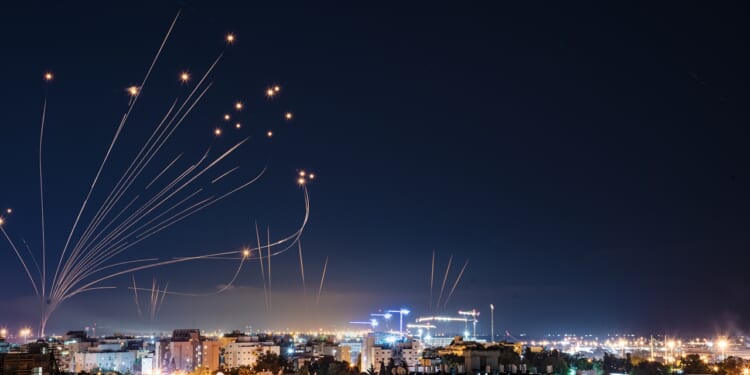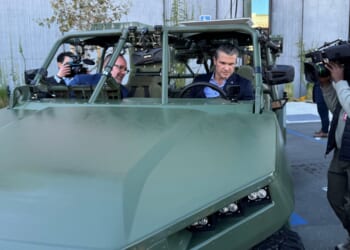Iran has many thousands of advanced missiles in its underground stockpiles. If the clerical regime were truly under threat, it would likely use them en masse.
The world is inching precariously close to another round of warfare between the Israelis and the Iranians. This time, the Israelis might be playing for keeps. While Jerusalem, backed by the United States, has considerable military advantages, it is obvious that its first round of warfare in June—the 12-Day War—was inconclusive. Otherwise, there would be no need for the United States to surge forces into the region again and prepare for a second round of fighting against Tehran.
Moreover, the Islamic Republic does have some systems that will complicate any offensive action directed against it.
A No-Limits Israel-Iran War Would Be Catastrophic
In a hypothetical war between Israel and Iran, Tehran possesses a robust suite of advanced missiles, notably hypersonic weapons, that could prove problematic for any offensives the Israelis have planned. The Fattah-1 and Fattah-2 hypersonic weapons are absolute gamechangers when it comes to giving Iran a reliable, non-nuclear strike capability.
These two hypersonic missiles would likely form the basis of any retaliation against Israel. Iran would integrate these two weapons into salvos combining slower drones, slower Shahed cruise missiles, and conventional ballistic missiles such as the Ghadr or Emad. The aim would be to overwhelm Israeli defenses, forcing them to allow some threats through while prioritizing others; the hypersonics would then serve as “penetrators” of sorts, exploiting their velocity to arrive first and create gaps for follow-on waves.
This strategy was partly effectively employed toward the end of the 12-Day War, in which Iran, contrary to the initial claims of the IDF, managed to unleash a series of missile fusillades at Israel that ravaged major cities such as Tel Aviv. Had the war continued in the fashion it was, the Iranians might have been able to land major blows with their missile salvos at Israel, if only because the otherwise impressive Israeli air defense systems would have been overwhelmed by the swarming tactics.
Since the summer conflict, Israel has done its best to replenish its spent supplies of interceptors and restore its air defense network. Clearly, Jerusalem believes it has accomplished the task. But the Iranians launched barely a fraction of the impressive missile and drone arsenal they possess. When the next iteration of the war initiates, Tehran may conclude that this is Israel’s attempt to “go for broke” in terms of decapitating their regime.
As such, Iran’s rulers may determine that they must unleash their capabilities more fully (or at least launch whatever the Israeli spies embedded throughout Iran don’t sabotage, as they had done in the 12-Day War) in a “use-it-or-lose it” burst.
What to Know About Iran’s Missile Force
Iran’s missile forces—using the Fattah-1 and/or Fattah-2s as “penetrators”—might include important Israeli airbases like Nevatim or Palmachim to neutralize fighter jets and reduce Israel’s air superiority or command centers to disrupt coordination. In the June 2025 strikes, Fattah missiles reportedly hit such sites despite Israeli defenses, demonstrating their role in piercing systems like the Israeli Arrow-3.
The Fattah-2’s Hypersonic Glide Vehicle (HGV) could enable mid-flight course corrections to avoid interceptors, making it ideal for evading radar locks and targeting mobile or hardened assets.
To counter US intervention via carrier strike groups or regional bases, Iran is also likely to target American installations within range—notably Al Udeid Air Base in Qatar, Al Dhafra Air Base in the United Arab Emirates (UAE), the US Navy’s major base in Bahrain, or individual naval assets in the Gulf.
The Fattah’s short flight times—under 10-15 minutes to targets more than 600 miles away—would limit US response windows, aiming to inflict damage before reinforcements arrive. Interestingly, the Iranians did not do much to threaten US facilities in the region during the 12-Day War, besides a perfunctory and massively telegraphed strike on Al Udeid toward the end. But if Iranian leaders really believed that Israel, with America’s backing, was coming to drop the hammer on them once and for all, they might decide to hit US targets with the greatest force they could muster. What would they have to lose?
Iran’s Missiles Are a Real Problem for Israel and America
Iran’s hypersonic weapon attack strategy might involve initial warning strikes on logistics hubs to signal escalation risks, deterring deeper US involvement as seen in analyses of Iran’s missile posture. The hypersonic element adds psychological deterrence, as US systems, like Patriot or the Terminal High Altitude Area Defense (THAAD) may struggle with highly maneuverable threats, like the Fattah-2.
Lastly, Iran could coordinate with allies like Hezbollah or the Houthis of Yemen to launch diversionary attacks from Lebanon and Yemen, stretching defenses and allowing Fattah missiles clearer paths. There are no reliable defenses in the West today against these weapons, and the Iranians have a large arsenal in stock. While the Israelis and Americans can likely collapse the regime if that is what they seek to do, the damage incurred—to say nothing of the chaos thereafter—would be greater than what many in Washington and Jerusalem assume.
About the Author: Brandon J. Weichert
Brandon J. Weichert is a senior national security editor at The National Interest. Recently, Weichert became the host of The National Security Hour on America Outloud News and iHeartRadio, where he discusses national security policy every Wednesday at 8pm Eastern. He is also a contributor at Popular Mechanics and has consulted regularly with various government institutions and private organizations on geopolitical issues. Weichert’s writings have appeared in multiple publications, including The Washington Times, National Review, The American Spectator, MSN, The Asia Times, and others. His books include Winning Space: How America Remains a Superpower, Biohacked: China’s Race to Control Life, and The Shadow War: Iran’s Quest for Supremacy. His newest book, A Disaster of Our Own Making: How the West Lost Ukraine is available for purchase wherever books are sold. He can be followed via Twitter @WeTheBrandon.
Image: Shutterstock / Vadim Litovchenko.


















